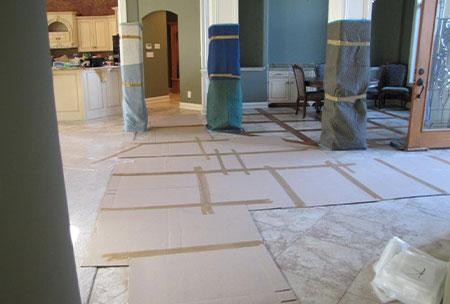There’s something deeply unsettling about the moment when your new appliances, furniture, or tech gadgets are being installed in your home. It’s a time filled with excitement, but also a quiet worry—what if something gets damaged or lost during the process? Our belongings hold not just monetary value, but memories, comfort, and pieces of our lives. That’s why understanding coverage during installation isn’t just a practical step—it’s a way to protect the things that truly matter to us. In this article, we’ll explore how to safeguard your possessions from unexpected mishaps, so you can embrace the joy of new beginnings without the burden of fear.
Table of Contents
- Understanding the Risks Your Belongings Face During Installation
- How to Choose the Right Insurance Coverage for Installation Periods
- Tips for Safeguarding Your Valuables Before Installation Begins
- What to Do if Your Property Gets Damaged During Installation
- To Conclude
Understanding the Risks Your Belongings Face During Installation
When your home undergoes installation work, whether it’s a kitchen remodel or new flooring, your personal belongings are unexpectedly vulnerable. Items that have stayed untouched for years suddenly face the risk of accidents, from dust and debris damage to accidental drops or spills. Even the most careful installers can inadvertently cause scratches, dents, or stains that leave lasting marks on your cherished possessions. This uncertain environment creates a stress-filled experience, where every fragile vase, sentimental photo, or valuable gadget feels like it’s walking a tightrope, just waiting for an unfortunate misstep.
Some common risks your belongings endure during installation include:
- Unintentional impacts from heavy tools or equipment
- Exposure to dust, paint, or chemicals that can stain or corrode surfaces
- Accidental water damage due to plumbing adjustments or spills
- Items being moved, stacked, or stored improperly, leading to breakage
Understanding these hazards is the first step in safeguarding your home. No one wants to deal with the disappointment of damage after eagerly anticipating an upgrade—it’s crucial to explore coverage options that offer peace of mind during this vulnerable process.
How to Choose the Right Insurance Coverage for Installation Periods
Choosing the appropriate insurance coverage during installation phases can feel overwhelming, but it’s essential to safeguard your valuable belongings from unexpected mishaps. Start by evaluating the specific risks associated with the installation environment—consider factors such as potential damage from equipment, property access limitations, and the duration of exposure. Look for policies that explicitly cover temporary relocation of items or include comprehensive protection against accidental damage during setup. Don’t settle for generic coverage; insurances tailored to installation periods offer peace of mind and focused protection, turning a vulnerable time into a secure transition.
When reviewing options, pay special attention to elements like liability limits, coverage for delays, and whether the insurer is familiar with installation-related claims. It’s wise to ask insurers about how claims have been handled in similar scenarios because the responsiveness and understanding of your provider can make all the difference when urgency strikes. Remember these tips as you decide:
- Clarify exclusions: Ensure there are no hidden gaps in coverage during installation.
- Verify replacement cost coverage: This guarantees you’ll be reimbursed for the full value of your belongings if damaged or lost.
- Consider supplemental riders: Specialized add-ons can bridge any policy limitations.
- Communicate openly: Let your insurer know about unique circumstances or risks during the installation period.
Tips for Safeguarding Your Valuables Before Installation Begins
Before the installation crew steps through your door, take a moment to secure your most cherished belongings. Even the most meticulous installers can unintentionally cause disturbances or misplace small items amidst the hustle. Clear countertops, shelves, and other work areas of any fragile or valuable objects, so that nothing is accidentally knocked over or damaged. Consider temporarily relocating family heirlooms, jewelry, or important documents to a safe place out of sight or inside locked drawers to offer an extra layer of protection.
In addition to physical safeguards, create a quick inventory of your valuables with photos or notes to ease any future verification needs. This simple act not only brings peace of mind but also empowers you in the rare event of damage or loss. Here are some easy steps to follow:
- Store electronics and sensitive items away in closed rooms or cabinets.
- Use soft cloths or padding under any items near the work zone.
- Label boxes or containers if you must move belongings temporarily.
What to Do if Your Property Gets Damaged During Installation
Discovering your property has suffered damage amid an installation can feel overwhelming and frustrating. The first step is to stay calm and document everything meticulously. Take clear photos and videos of the affected areas, noting the date and time. This visual evidence will be invaluable when communicating with your installer or insurance company. Next, reach out to the installation team immediately—polite but firm communication can often accelerate resolution. Many reputable installers have protocols to address such issues and may offer repairs or compensation. Remember, your peace of mind is crucial, so don’t hesitate to ask detailed questions and request a timeline for repairs.
Meanwhile, familiarize yourself with your insurance policy to understand the extent of your coverage. If you’re uncertain about coverage details, contacting your insurance agent can provide clarity and reassurance. Keep a detailed log of all communications, including phone calls and emails, to ensure nothing slips through the cracks. Here’s a quick checklist to empower you during this stressful time:
- Document damage immediately with photos and videos
- Contact the installer promptly and professionally
- Review your insurance policy for coverage specifics
- Keep a written record of all communications
- Request a clear repair timeline and follow up regularly
To Conclude
In the end, protecting your belongings during installation is about more than just safeguarding your stuff—it’s about peace of mind. When you know your valuables are covered, you can focus on the excitement of creating a new space, rather than worrying about what might go wrong. Installation is a moment of transformation, and with the right coverage in place, you’re free to embrace that change without fear. So take the steps to protect what matters most—you deserve that security, now and always.







